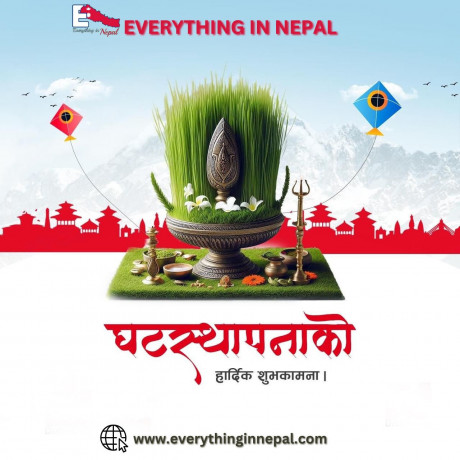Ghatasthapana: The First Day of Dashain in Nepal Professional
Oct 3rd, 2024 at 13:37 Blogs Kathmandu 179 views Reference: 1539Location: Kathmandu
Price: Contact us
Ghatasthapana marks the beginning of Dashain, the most significant and widely celebrated festival in Nepal. Dashain is a 15-day-long Hindu festival that commemorates the triumph of good over evil. Ghatasthapana, the first day of Dashain, holds deep cultural, religious, and agricultural significance. It signifies the start of the rituals dedicated to Goddess Durga, invoking her power and blessings for the prosperity, protection, and well-being of the family.
Significance of Ghatasthapana
The word "Ghatasthapana" is derived from two Nepali words: "Ghat," meaning pot, and "Sthapana," meaning establishment. It symbolizes the establishment of a sacred vessel (kalash), representing the goddess Durga, who is believed to reside in it for the duration of Dashain. This ritual is rooted in the ancient Hindu tradition of honoring the Goddess Shakti, who embodies power, strength, and protection against negative forces.
The day also signifies the official start of the festive season, bringing joy, hope, and renewal to families across Nepal. Traditionally, it aligns with the agrarian cycle as well, occurring just after the monsoon harvest, marking a time of abundance and celebration.
The Rituals of Ghatasthapana
The main ritual on Ghatasthapana involves the planting of "Jamara," sacred barley seeds, which are to be nurtured and grown throughout the festival. The planting takes place in a special area of the home or in temples, where a kalash (a sacred vessel filled with holy water) is placed at the center of a sand bed. Barley seeds are then sown around the kalash, and the area is covered, keeping it dark and moist to ensure the growth of Jamara, which symbolizes prosperity and the blessings of Goddess Durga.
This ritual takes place during an auspicious time determined by Hindu astrologers. It is performed by the head of the family, who recites prayers and mantras to invoke Durga's blessings. A lamp, called the "Akhanda Jyot," is lit and kept burning continuously for the entire duration of the Dashain festival, representing the goddess's presence in the home.
The Jamara, once grown to about five or six inches by the tenth day of Dashain (Bijaya Dashami), is used as a ceremonial offering. Elders place it on the foreheads of family members as a token of blessings for health, prosperity, and protection from evil.
Cultural and Social Aspects
Ghatasthapana is not just a religious observance but also a time for family gatherings and social bonding. Many Nepalis living abroad make it a point to return home for Dashain, as it is a time to renew familial ties and connect with cultural roots. The significance of Dashain, starting with Ghatasthapana, is deeply embedded in Nepalese culture, as it brings together people of different backgrounds to celebrate together.
Moreover, in rural areas, Ghatasthapana holds additional importance, as it coincides with the end of the harvest season. Farmers offer their thanks for a bountiful crop and pray for continued prosperity in the coming year. This connection between the festival and agricultural life underscores Dashain's importance in Nepal's agrarian society.
Conclusion
Ghatasthapana is a day of spiritual renewal and a cultural celebration that sets the tone for the rest of the Dashain festival. It brings families together, connecting them to their religious traditions and to each other, as they begin preparations for the most joyous time of the year. With its deep symbolism of prosperity, protection, and the triumph of good over evil, Ghatasthapana remains one of the most important rituals in Nepalese culture, heralding a period of festivities, joy, and unity.


